- Flight path KML: Brian Mayer found Google Earth’s flight simulator’s learning curve steep, “so I decided to create a set of runway outlines and flight paths to serve as guides for getting from Point A to Point B.” The result is a KML package of 239 runways in 94 cities with 24 flight paths between them. I took it for a spin, and sure enough, I managed to land without crashing for the first time ever.
- Avi Bar-Zeev to Microsoft: Keyhole co-founder Avi Bar-Zeev writes on his blog that he has just joined Microsoft. Avi left Keyhole in 2001 — Keyhole was acquired by Google in 2004 and its Earth product became Google Earth in 2005. What will he be working on?
As to what I’ll be working on, keep in mind, my new supervisor actually found me and recruited me via this blog. That might help you make some guesses as to what we’re interested in.
And on his blog, he’s been writing perceptive posts about the 3D internet lately:-)
- Thinking about future location: I ended up watching Peter Batty’s entire presentation at GeoWeb on “Future Location and Social Networking“. I hadn’t planned to, but I was surprised to find a lot more deep thinking than I imagined was possible about this market segment. Peter’s put a lot of his thoughts into action with whereyougonnabe, a FaceBook application that competes with Dopplr. At the end of the video, there are some cool Google Earth visualizations.
- Improvements in Google Maps ads: Valery Hronusov forwarded this, in case not all Google Maps developers had seen it. The Google Maps API now has much improved handling of Google ads, so you might want to go revisit your code.
- EarthBrowser presentation: Matt Giger of EarthBrowser presents a Google Tech talk about his virtual globe, in which he also makes the case for a better representation of time in KML. In a separate post, he looks forward to Flash 10, as it would give him the ability to add 3D terrain to EarthBrowser.
Category Archives: Uncategorized
Links: Microsoft frees trueSpace, novel map use, British Columbia frees geodata
- Microsoft frees trueSpace 3D authoring tool: Microsoft’s Chris Pendleton over on his blog announces that trueSpace 7.6 — the $595 3D authoring tool by the recently acquired Caligari — is now free for all to download (Windows only), putting it smack in the same competitive space as Google SketchUp, with a similar ability to create 3D models and then position them on a virtual globe, in this case Virtual Earth. Chris’s post is detailed, and he implies that trueSpace is a much more advanced tool than SketchUp. (I haven’t had a chance to compare.)
Not sure where this leaves Dassault Systemes 3DVIA, which Microsoft integrated into Virtual Earth as a kind of browser-based 3D authoring competitor to SketchUp. Ironically, it turns out that while Google’s been working on a browser-based version of its stand-alone virtual globe, Microsoft’s been working on acquiring a standalone replacement for its browser-based 3D authoring tool:-)
- Novel map use: Clyde Ford writes:
Thought you might be interested in my new geo-mashup that integrates VE and GE, switching between the two for the best satellite imagery. I’m a long-time software developer, but also a thriller writer, who wanted to design a site that allows readers to fly-to places in my book and once there to enjoy multimedia experiences. Hang out on the site long enough and you’ll hear Morgan Freeman’s voice talking about Precious Cargo, my latest book.
It’s Windows only for now. For a book that name-checks a lot of locations (as a nautical novel is wont to do), this is certainly an interesting way of making places come alive.
- British Columbia geodata in Google Earth: The Map Room finally made me look. Here is a belated link to guided tours of some lovely geospatial data of British Columbia in Google Earth.
Sentinel AVE: Fuse live streaming videos to the 3D landscape (!)
Back in April 2006, Ogle Earth flagged GeoDec, a research project by grad students at the University of Southern California that allowed you to project live video streams onto a 3D landscape. The research had support from both Google and Microsoft, and came with an eye-popping video of what the future held.
 The future is now. GeoDec’s demo site is gone, but out of its ashes comes Sentinel AVE, a company, and Augmented Virtual Earth (AVE), their product. USC’s researchers have turned their project into a business. And good for them.
The future is now. GeoDec’s demo site is gone, but out of its ashes comes Sentinel AVE, a company, and Augmented Virtual Earth (AVE), their product. USC’s researchers have turned their project into a business. And good for them.
As told by this impressive video demo, AVE is a fully fledged virtual globe with 3D DEMs, textured urban buildings, accurate sun positioning and support for KML as well as buildings taken from Google’s 3D Warehouse. But the single most impressive feature is the seemingly scalable ability to “fuse” any number of streaming videos to the landscape, so that surveillance cameras can collectively paint a a whole region in live 3D video.
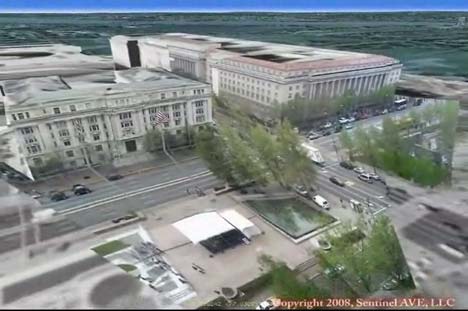
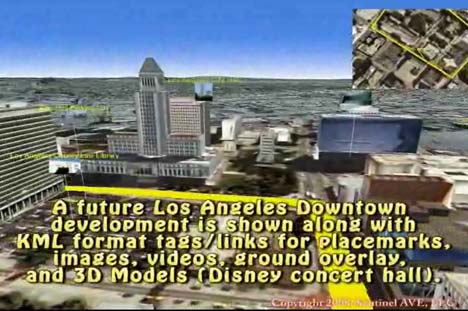
That’s a first. Yes, Second Life has the ability to show a video in-world onto a screen, but an avatar can only see one at any one time. SkylineGlobe also lets you add 2D video clips in their globe, but you can’t distort the projection so that it fits around a 3D object, like AVE does. Sentinel AVE seems to have cracked the scalability issue, something which their video says involves a patent pending method. According to them, AVE runs on current laptops (though I’m guessing it’s Windows only).
If you visit Sentinel AVE’s about page there is no doubt that much of their original backing is (US) military in nature. But the video’s virtual visit of the Googleplex and the seamless integration with Google’s 3D Warehouse hints at some collaboration with Google’s geo team.
If you want to buy Augmented Virtual Earth, you need to send them an email. If you have to ask how much it costs, though, you probably can’t afford it, and that’s probably because you’re not the military, a city or big company wanting 3D video surveillance of a region. Still, today’s cool new technologies are tomorrow’s Google acquisitions, right?:-)
Five years from now, we may all be pointing our webcams out the window, contributing to a global live 3D video mosaic open to all. Then Google Earth (or a live video version of Microsoft’s Photosynth in Virtual Earth) would do to surveillance what it did to remote sensing intelligence gathering — bring it to the masses, replacing big brother with millions of little brothers. (Via Diserto)
Links: Ipoki + Qik = georeferenced mobile phone video webcasting
- Finally! Live georeferenced mobile phone web video: Live mobile phone video streaming site Qik and live GPS phone position site Ipoki have collaborated to let you live stream video from your mobile phone to the web while also showing your location in real time. Here’s the obligatory YouTube showing it off:
This is the first instance I am aware of where you can publish live georeferenced video to the web from your mobile phone. (Seero lets you do it from your GPS enabled laptop with video camera.)
- Where is Captain Bill? Virgil Zetterlind of EarthNC writes:
Captain Bill Foster and EarthNC have partnered to live-cast the delivery of a 46′ cruiser from New Buffalo, Michigan to Marco Island, Florida starting today the 22nd of July. Capt Foster and his crew are presently in the Chicago area and will begin to traverse the city via the Chicago River at approximately 2pm EDT this afternoon.
Via cell-phone aircard, Capt Foster is uploading his position and a webcam image approximately once per minute to EarthNC.com. You can watch his track in Google Maps and Google Earth and see his latest photos here. His position and images will automatically update so long as he has an available cell data connection
- One Man Resting: A few days ago Craig Stanton finished his walk across Japan, which he documented on georeferenced video using Seero.
- Near real-time aerial imagery? Perhaps the most-heard complaint about the free aerial and satellite imagery in Google Earth and Virtual Earth is that it sometimes is a few years old. If an Australian company gets its way, this may soon change. From an ITWire article:
According to [Perth-based] Ipernica, “NearMap’s technology enables very high resolution aerial photomaps with multiple angle views to be created at a fraction of the cost of traditional solutions… For the first time, people will be able to see the environment change over time, as NearMap’s online photomaps allow users to move back and forward month by month to see changes occur, such as the construction of a home or development of a new road. [And] with NearMap’s revolutionary approach to high resolution photomaps, it has achieved its objective of a 20-fold operating cost reduction over current industry practices.”
Panning not just through the X and Y axes but also through time would definitely be cool. Let’s just hope it’s as scalable as advertised. There’s more details in the ITWire article.
- Afghan archaeology redux: The Sydney Morning Herald has an article on David Thomas’s use of Google Earth to map Afghan archaeological sites, and it comes with another fine aerial shot of a Ghaznavid fortress in the Registan desert. This one I couldn’t locate at all, however. Does anyone else have any better luck?
- Virtual Earth update (including Berlin): Lots of new imagery for Virtual Earth, especially for Europe, and including bird’s eye imagery for all of Berlin, where I happen to be summering. Check out that architectural wonder of an airport, Tempelhof, smack in the middle of the city, to which I walked a few weeks ago to take a flight. That very same day was also the 60th anniversary of the start of the Berlin Airlift. I made a small portfolio of photos on Flickr of Tempelhof, as the airport is slated to close soon.
(PS, looks like I still can’t embed Virtual Earth maps on a web page, or I would have done so here instead of giving you a URL to the airport.)See comments. - QSL2KML: Amateur radio operators use QSLs as a way of confirming reception of a broadcast in faraway places. As they are by nature georeferenced, they’d make a great KML file. And that is precisely what KML My QSLSs does, for free.
- Geonames unplugged: The Map Room points to a 1930s globe “with a complete index and gazetteer inside it.” Just in case we start to take Geonames for granted.
- Satellite imagery primer: Discover Magazine on the rise of ubiquitous free satellite and aerial imagery on the internet. Interesting primer on much of what this blog has covered the past three years. One excerpt makes an ironic point:
Indeed, while the U.S. government prohibits sale of satellite imagery with ground resolution better than a half-meter [of the US by US-based companies], no such rule applies to images from nonsatellite sources. So while a satellite company may be forced to “fuzz up” an image of, say, CIA headquarters in McLean, Virginia, to meet the half-meter standard, that same picture is available in even sharper focus from aerial photographs on Google Earth.
In the rest of the world, the situation is the other way round. US satellites can take as much imagery as they want from space (with the sole exception of Israel and the Palestinian Territories), but aerial photography — such as that of the Netherlands used in Google Earth — is subject to censorship by the sovereign power because it is taken from the national airspace. (Via All Points Blog)
HeyWhatsThat visualization tools for August 1 solar eclipse
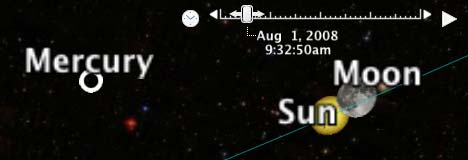
Michael Kosowsky of HeyWhatsThat writes:
I’ve enhanced HeyWhatsThat‘s astronomical sites for the August 1 total solar eclipse [over Siberia]. By using topocentric rather than geocentric place for the Moon and interpolating planetary positions, the images now better match what I’d guess is the gold standard: NASA’s Solar Eclipse Web Site (If you’re going to spend time or money traveling to see the eclipse, please use their numbers, not mine.)
The planisphere:
- This KML file is an animation for the spot in Siberia projected to see the maximum eclipse.
- If you visit the planisphere site (or the advanced planisphere) you can generate Google Earth KML animations of the eclipse for any other location.
The cosmic visibility site:
- Visit the site and you can see a simulation of the eclipse in your browser, again for either your own location or the eclipse maximum in Siberia. Just click on one of the “August solar eclipse” links under “interesting events”.
As of this writing the “Earth” tab doesn’t show the path of the Moon’s shadow, but the NASA site does a great job of that here. Be sure to click on their map to get the eclipse circumstances for any location.
With the new Google Earth API — the ability to put Google Earth inside a web browser and control it programmatically — I hope to merge a lot of the planisphere and cosmic functionality into a single site… but probably not before the eclipse.
Google Earth Blog also has an entry with a KML link to the path of totality for the eclipse.
Second Life map of Sweden
Swedish programming virtuoso Magnus Zeisig as just published an accurate 3D map of Sweden in Second Life that can be scripted to show all kinds of data and run all sorts of animations. You can visit it in Second Life here, and it looks like this:

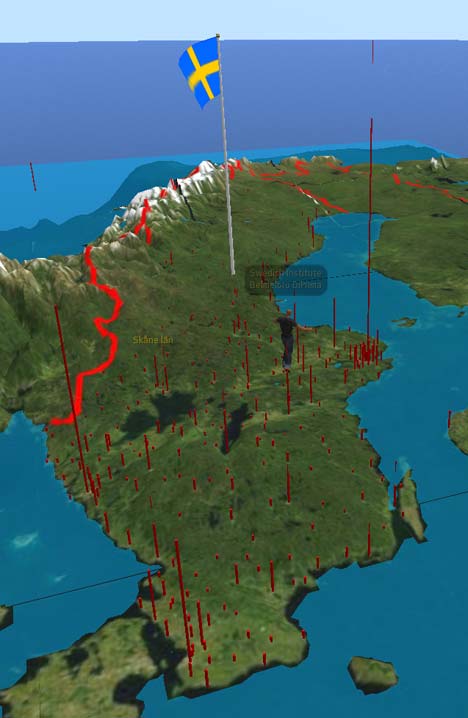
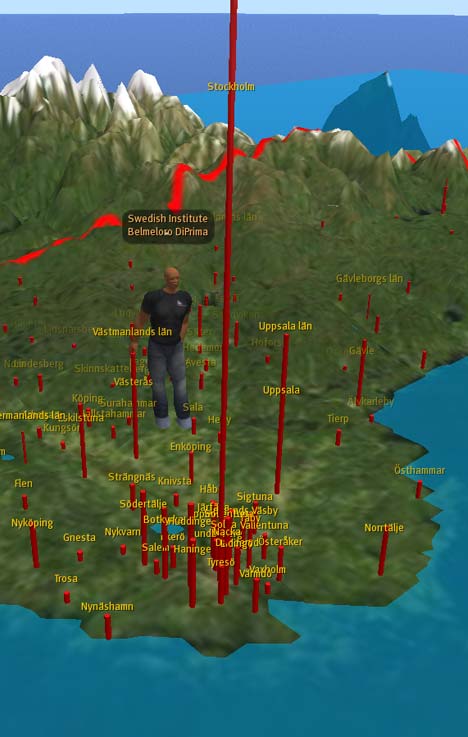
How did he make it? Magnus writes:
Topography data were processed using PERL programs of own design. Topography data and geographic data were conically projected using the program DAZ/Eovia Carrara. Population and area data were processed using Microsoft Excel and Visual Basic programs of own design. Final topographic sculpt, geographic and heraldic images were prepared using Adobe Photoshop.
Magnus used Second Life’s sculpted prims to build the landscape, and on top of it you can today turn on/off “layers” with city names and cylinders that represent population, which is done using the Linden Scripting Language. (When you visit, click on the map for animation options and more info.)
Magnus has more in store, including a search function and animations for ship and rail traffic. It certainly not as easy as making a quick and dirty KML file for Google Earth, and no doubt takes more work than building something with the new Google Earth API, but when it comes to programming an interactive 3D map to measure, this example shows it’s certainly feasible in the versatile 3D programmable space that is Second Life. (Previously on Ogle Earth: Magnus’s planetarium in Second Life)
Havana panoramas on 360 Cities
For all US Americans who are by law prohibited from setting foot in Cuba, you can now experience Havana virtually via over 100 high-resolution georeferenced 360-degree panoramas, just published to 360 Cities. In Google Earth too, of course:
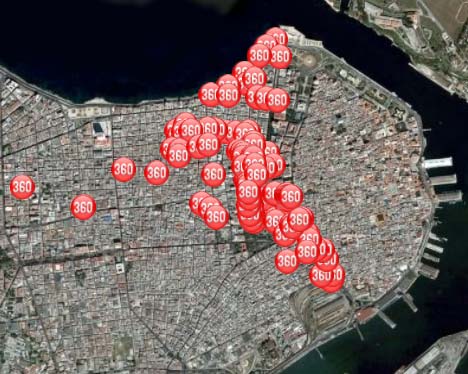

What a wonderful snapshot in time. Havana is bound to change immensely in the next decade or two.